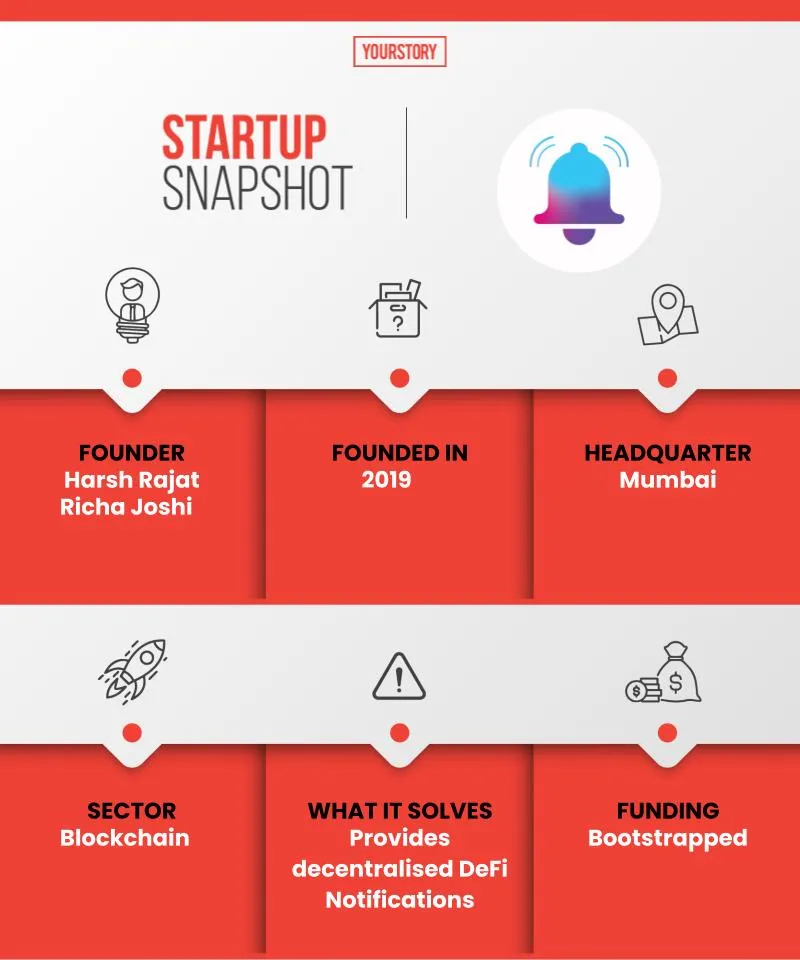Why this husband-wife duo felt the need for blockchain-based push notifications
EPNS is a decentralised DeFi notification protocol (smart contract) which any dApps or services can use to send beautiful notifications to the wallet addresses of Ethereum.
Harsh Rajat and Richa Joshi worked in the blockchain, fintech and SaaS space and companies like Deloitte and Wipro for over a decade, before looking to start up. The husband-wife duo wanted to do something in the blockchain space and create the next web.
They realised one thing - blockchain in 2019 behaved the same way as it did in 2003. Most services expect the users to keep coming back to them, and blockchain just doesn’t have notifications. It led them to start Ethereum Push Notification Service () in January 2020 in Mumbai.
Notifications in general do not exist on the blockchain, which is hard to imagine coming from traditional web services, where people get notified about their next meeting, email, payments or social invites. EPNS decided to solve this.
What does EPNS do?
The platform allows services to send notifications to the wallets. But apart from just notifications, users also earn from receiving the notifications. Since the encrypted data of these notifications is stored on the blockchain (directly or indirectly), it not only enables the team to send push notifications out to mobile or tablets but essentially to any centralised or decentralised carriers.
The notifications can be delivered in a platform agnostic way to mobiles, tablets, web browsers and even to favourite wallets of web3 (Metamask, Trust, etc).
“Despite this growth and expanding usage of blockchain tech, the services (dApps, services, smart contracts) still lack a genuine communication medium with their users, sometimes filled by alternative communication mediums like twitter, telegram or email. Notifications are seven times more powerful than these mediums to deliver information,” explains Harsh.
The company has a global team of nine members who have known each other for many years. The team includes Jafett Sandi, the Product and Development Lead and Andrew Redden, who is the Protocol and Research Lead.
“The remaining team brings varied experiences and skills across domains and has helped shape the project with a single goal of building a unique product which did not exist earlier,” adds Harsh.

Difference from regular notifications
While the duo had experience in building notifications and blockchain, most push notifications are centralised and require association of device ids to usernames (for example: Facebook knows you have signed in because they have a server monitoring that).
When customised notifications to devices are sent, they are complex as two services generally work on different principles, and one is usually serverless and the other requires a server - to form a connection between them is difficult.
“EPNS cleverly solves this issue by abstracting the data layer on-chain and creating a sign-in which doesn't even send out any private credentials or centralised sign-up for users,” says Harsh.
The team connects the decentralised platforms to a centralised one by disassociating storage of data / config and intended recipients on-chain, which can then be picked up by the infrastructure using the solutions (or other third party infrastructure if they want to build on top of our protocol) and can be relayed to centralised services (mobile, tablet, web, etc). They can also be picked up by decentralised services and shown like a twitter feed (for example: the Alpha dApp).
How does it work
“We see notifications as a means to communicate information of different types, carry different utilities and perform different tasks as per their use cases. To enable this, we assign each notification payload a payload type that defines certain characteristics of both the data they carry and the medium of storage,” explains Harsh.
These in turn are stored and treated like JSON payload, which is transformed as per the rules of the different carriers when the notification reaches them. JSON Payload can differ with payload types which ensures the flexibility of the content, data, storage interpretation and delivery. This helps in creating different rules and content interpretation of the notification (for example: carrying images, call to action, live videos, etc).
The protocol allows users to be in direct control of what services they get notification from, it imposes rules on the services including spam protection for users, limiting their ability to add wallets as subscribers, etc. The protocol also incentivises users who receive the notifications.
This on-chain abstraction of data enables delivery to centralised as well as decentralised carriers, and notifications are treated more like a social feed (e.g. Twitter) than an ephemeral piece of information (though means to do so also exists). It also enables rules, incentives, settings and configuration to be retrieved from a single source of truth and is not dependent on a single point of failure.
“Storing the JSON payload on decentralised storage and just its pointer / hash on on-chain logs enables cost optimisation. Though the protocol also allows storing the entire payload on-chain for services that intend to do so. Abstracting the data layer on chain (directly or indirectly) ensures notifications are platform agnostic and available on decentralised mediums as well (e.g. dApp, wallets that might not want to trust a central point of truth),” explains Harsh.
The blockchain space
Blockchain as a sector is still in its nascent stage in India. However, startups like Binance, Unocoin, WazirX and others are focused on Blockchain and the crypto space, and, use cases are slowly expanding. Tech30 startup, Senderment, uses blockchain technology to make it simple for global businesses to collect data from individuals, with their explicit consent.
The EPNS team had taken the idea to Ethereum Foundation, when they were guided to ETHGlobal’s HackMoney, a virtual 30-day hackathon. EPNS was selected and mentored by global design firm IDEO in their product validation day (PVD) and then got selected for Gitcoin Kernel accelerator / incubator.
EPNS charges services staking fees to activate the notifications. This goes through staking - lending - interest part to generate revenue, which is then given to the users who opt to receive notifications from these services.
“The main revenue comes from charging micro fees to the service when they send notifications. This micro fee is set in a decentralised manner and the governance part of the protocol handles that,” explains Harsh.
He adds that the team is exploring InterPlanetary File system (IPFS) to form a decentralised communication system between users. Harsh explains, “IPNS is a static file on IPFS that points to your website that's hosted on IPFS. We are researching ways in which we can use this to potentially form several communication points that are enabled between user to user. This can lead to exciting possibilities, for example, having a chat thread on IPFS that carries with itself the previous hash (cid) and IPNS keeps on updating the latest hash as a pointer towards that chat. This can also be explored to give way to possible decentralised video messaging and other exciting breakthroughs.”
Edited by Anju Narayanan




![[Tech30 Special Mention] How Gurugram startup Shippigo is digitising logistics for online SME sellers](https://images.yourstory.com/cs/2/a9efa9c02dd911e9adc52d913c55075e/Imagel5nr-1603886247391.jpg?fm=png&auto=format&h=100&w=100&crop=entropy&fit=crop)
![[Product Roadmap] How bitcoin startup Unocoin dealt with legal trouble and garnered 1.3M users](https://images.yourstory.com/cs/2/a9efa9c02dd911e9adc52d913c55075e/rmp-1604386390693.png?fm=png&auto=format&h=100&w=100&crop=entropy&fit=crop)




